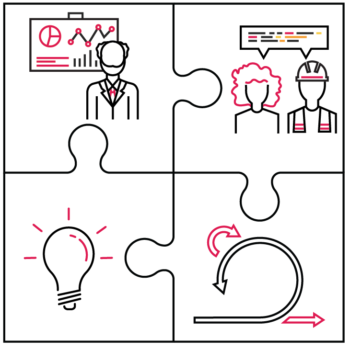Project Management vs Product Management: What is the Difference?
Project to Product Thinking Part 1
Before agile was at the center of the software development world, project management processes dominated. A traditional project consisted of mass research to develop a master plan, assigning projects to developers, and then, eventually there would be a finished product ready to launch.
But in most cases, by the time the project was close to launch, the market had already changed and so did the customer’s wants and needs. Which led to a lackluster reception, resulting in the product being pulled back for massive overhauls, or even scrapped completely.
Implementing agile into software development solved a lot of these issues drastically improving the project “system”. But the same issues that broke the system in the first place still exist, and consequently, organizations are still facing the same challenges the old system was known for.
So what’s the solution? Traditional projects are linear. They have a beginning and an end, and by nature, are not set up to take a rapidly changing market into account. Product Management however is cyclical, not linear. In order to remove traditional project obstacles, and be truly agile, organizations need to practice what we like to call Product Agility. To fully understand what product agility is, we need to first define project management vs product management in this context:
What is a Project?
According to the Project Management Institute, “a project is a temporary endeavor undertaken to create a unique product, service, or result.” In a software development context, even though every project is different, they all share several common attributes, for example:
- The project has a set start and end time with a detailed plan including major milestones.
- Effective management and execution of the project is measured by how closely the plan’s time, budget, and scope is followed.
- The work is assigned to ad hoc teams and sometimes even individuals based on what’s needed to reach the next milestone.
- The project is finished when the product, service, or result is created. Any changes based on customer feedback, enhancements, or future maintenance would constitute a different project.
- The project is considered successful if it was completed on time, within scope, and under budget. Product impact and customer satisfaction are often overlooked.
What that translates to is that traditional project management flies directly in the face of nearly everything the Agile Manifesto declared. You might think it would be impossible for anything like a project to make its way into a supposedly agile development organization, but it does; a lot.
What is a Product?
A product is anything you build or any service you provide that has impact. This is a significant shift in the way you think about work. Organizations who have been able to make that shift are now operating under the following principles:
- A product has no inherent start and end points, so it expands to include all necessary changes or maintenance along the way.
- The same core group of experts work together throughout the product’s entire lifespan, allowing for deep expertise and a tight-knit working environment.
- Success is measured based on the frequent delivery of value to the customer across the product’s lifespan. (Short success is measured based on the impact the product has in its market.)
Although thinking of your development work in terms of products (rather than projects) falls far more in line with the agile principles defined within the Agile Manifesto it’s still at odds with some common agile practices. For example:
- Scrum gave us the product backlog which is a single, prioritized list of stuff to do. But Scrum also gave us the product owner – the voice of the customer – who writes epics and stories, and orders them.
- The output of a sprint is a “product increment.”
- In SAFe® we have stories, features, capabilities, and epics. We break down and plan work into both Program Increments (PI) and Sprints.
- Lean Startup is seeking to identify and release an MVP as soon as possible for the purposes of validation and learning.
Now that we have broken down Project Management vs. Product Management, the distinctions should be evident. Jeff Gothelf and Joshua Seiden, the writers of the Sense & Respond Blog, outline the three fundamental mindset differences in Project vs. Product.
- Projects end. Products are continuous: Projects are one time events whereas products are ever-evolving cycles that don’t have a defined end.
- Projects are linear. Products are circular: Projects can be checked off as done while products are continuously learning and adapting to the environment.
- Projects are components. Products are systems: Product thinking allows teams the ability to adjust to unpredictable consumer needs and market demands as each variable occurs.
Product Agility
Now that you know the differences between Project Management vs Product Management, “Product Agility” becomes clear:
Product Agility is the focus on delivering value to the customer, often, through fast, iterative cycles of discovery and delivery. As a result, it addresses one of the biggest issues traditional project management never could. It takes into account shifting market demands and customer needs to ensure we’re not just completing what we were asked to build; we’re building the right thing at the right time.
Cprime’s Product Agility solutions help product teams get from planning to launch faster. Learn how you can gain more responsiveness to market and obtain higher rates of return from your product investments through our teaching and coaching.




